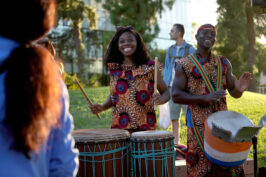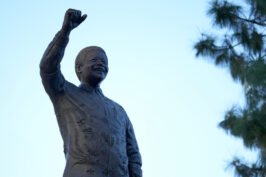The joyful sounds of the African Drum Interactive beat through the Fresno State Peace Garden like a chorus of exuberant heartbeats on Sept. 12, kicking off the unveiling ceremony for the latest addition to the monument statues honoring peacemakers from around the globe.

A life-sized bronze statue of anti-apartheid activist, former South African president and Nobel Peace Prize winner Nelson Rolihlahla Mandela stands just east of the Rev. Dr. Martin Luther King Jr. statue, facing the Fresno State Library from in front of the Professional Human Services building. This is the first new statue added to the garden in nearly 20 years.
“Nelson Mandela is a magnificent addition to our Peace Garden, as he believed in the power that education has to forge a socially conscious individual who works for an equitable world,” said Fresno State President Saúl Jiménez-Sandoval. “With his core belief in the power of the individual, Mandela will inspire our students to reach new levels of excellence, which in turn will enrich all of our diverse communities and world.”

The statue design was initially led by Colorado artist Ed Dwight, a military fighter pilot with the U.S. Air Force and America’s first Black astronaut candidate. When Dwight was unable to continue with the project, Jose Lopez — a Fresno State graduate art student — carried Dwight’s vision to completion with support from art and design professor Ed Gillum.
The statue features incredible details, from the intricate designs on Mandela’s African-patterned shirt to the laces on his shoes. Mandela’s trademark broad grin lights up his face as he raises his right fist in solidarity with his country men and women in the struggle against oppression.
The Mandela statue joins those honoring Mahatma Gandhi (installed in 1990), Cesar Chavez (1996), the Rev. Dr. Martin Luther King Jr. (1999) and Jane Addams (2006).
Planning for this latest addition to the Peace Garden has been years in the making. The Nelson Mandela Monument committee began meeting in 2016.
Dr. Siyabulela Mandela, a human rights scholar, delivered a keynote address titled “Reconciliation: Fostering Peace Through a Search for Common Grounds.” He talked about the original first name that Nelson Mandela’s father gave him — Rolihlahla — its meaning and how that played out in Nelson Mandela’s legacy.

“Rolihlahla in our language means the troublemaker. I do not know whether [his father] Chief Gadla had already envisioned the life that Mandela would live beyond the years that he spent with him. I do not know whether Chief Gadla understood the impact that this name would have on Mandela and the impact that this name would have for South Africa, the role that this name on its own would play in the history of South Africa, in the history of the African continent and in the history of the world as a whole.”
Jordyn Smith and Jourdan Williams sang an a capella version of the “Black National Anthem.” The young women’s voices rose powerfully into the evening as a crowd of about 250 gathered — students, employees, friends of the university and community members.
The Fresno State Chambers Singers, led by Dr. Cari Earnhart, performed several musical numbers — ”The Star Spangled Banner” and spirituals “We Shall Walk Through the Valley in Peace” and “Wade in the Water.”
During his keynote speech, Dr. Siyabulela Mandela referenced the lyrics from “Wade in the Water,” tying it back to his message about the “trouble” Nelson Mandela caused in his lifetime:
“As Dr. Cari and her team beautifully passed the message to us, they sang, ‘There’s something in the water. God will come and trouble the water.’ Perhaps it is now time to trouble the water. Perhaps the presence of the Mandela Monument, it is not only a living testimony that there’s power in our unity as members of the human race, but it is also a living testimony and a reminder to say there’s power in our united action as members of the human race.”
Dr. Veena Howard, a philosophy professor, chair of the Department of Philosophy and endowed chair in Jain and Hindu Dharma and the director of the M.K. Gandhi Center: Inner Peace and Sarvodaya, wrote an op-ed column for The Fresno Bee, explaining the significance of the Mandela Monument at Fresno State. Howard organized the unveiling event and acted as emcee.

“Mandela may have lived thousands of miles away, but his lessons on truth and reconciliation resonate globally and locally, here in the Central Valley,” Howard wrote. “His lifelong commitment to justice, unity and healing transcends geographic boundaries, offering valuable guidance for communities everywhere. Fresno State’s Peace Garden with the new monument to Mandela offers powerful examples to our students and community of how the path of resistance to injustice, reconciliation, open communication and empathy can help bridge divides and foster lasting change, right here at home.”
Dr. Sudarshan Kapoor, a professor emeritus at Fresno State who has spearheaded the planning of monuments in the Peace Garden since it was established in 1990, expressed his elation.
“It is a dream come true to see that Nelson Mandela is now enshrined in the Peace Garden alongside other icons of peace, justice, nonviolence and human rights,” Kapoor said.
As red drape was removed, revealing the monument, the ceremony concluded with a blessing as guests were invited to put garlands of white flowers, symbolizing peace, at the base of the monument.
The Nelson Mandela Monument unveiling was presented by the Fresno State Office of the President and the M.K. Gandhi Center: Inner Peace and Sarvodaya and supported by the Africana Studies Program.


